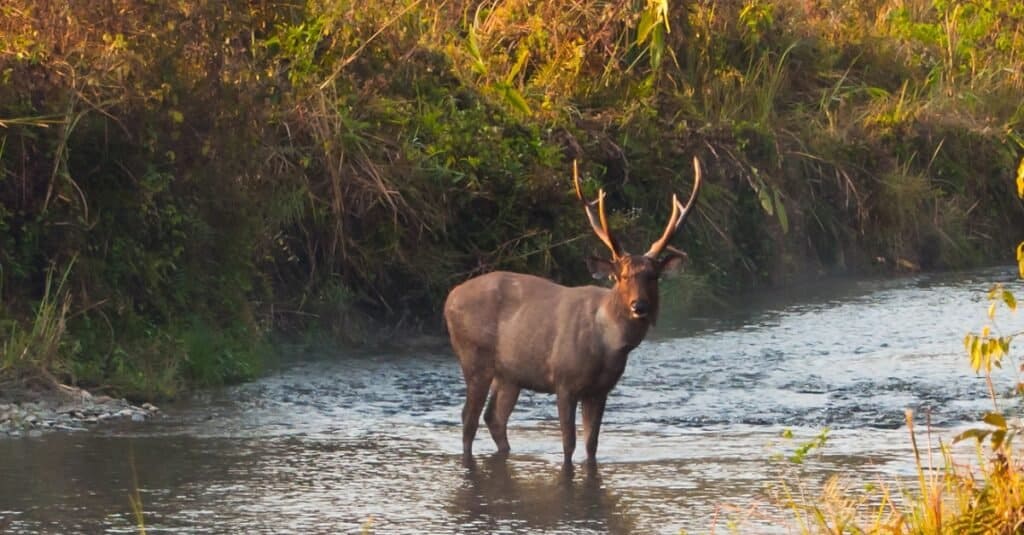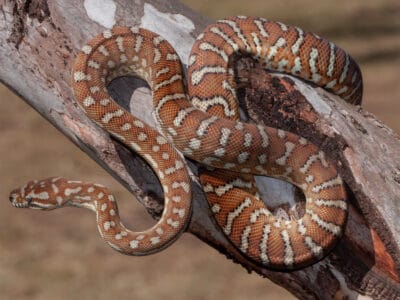Sambar
.jumbotron {
background-image: url(“https://a-z-animals.com/media/2022/02/Sambar-header-400×300.jpg”);
}
}
@media only screen and (min-width: 641px) and (max-width: 920px) {
.jumbotron {
background-image: url(“https://a-z-animals.com/media/2022/02/Sambar-header-470×370.jpg”);
}
}
@media only screen and (min-width: 921px) {
.jumbotron {
background-image: url(“https://a-z-animals.com/media/2022/02/Sambar-header.jpg”);
}
}
Sambar
Rusa unicolor
Male sambars will compete for mates by clashing together with their antlers
Sambar Scientific Classification
- Kingdom
- Animalia
- Phylum
- Chordata
- Class
- Mammalia
- Order
- Artiodactyla
- Family
- Cervidae
- Genus
- Rusa
- Scientific Name
- Rusa unicolor
Read our Complete Guide to Classification of Animals.
Sambar Conservation Status
Sambar Facts
- Name Of Young
- Fawn
- Group Behavior
-
- Solitary/Group
- Fun Fact
- Male sambars will compete for mates by clashing together with their antlers
- Estimated Population Size
- Unknown
- Biggest Threat
- Habitat loss and hunting
- Most Distinctive Feature
- The large antlers of the male
- Other Name(s)
- Sambhur or sambur
- Gestation Period
- 8-9 months
- Litter Size
- 1-2 fawns
- Habitat
- Forests and grasslands
- Predators
- Humans, tigers, leopards, and dholes
- Diet
- Herbivore
- Favorite Food
- Leaves, berries, grasses, bark, fruits, herbs, and buds
- Type
- Mammal
- Common Name
- Sambar
- Number Of Species
- 1
- Location
- South Asia
This post may contain affiliate links to our partners like Chewy, Amazon, and others. Purchasing through these helps us further the A-Z Animals mission to educate about the world’s species..

Spiders that fly! Fish that walk! And 1000+ more incredible animals. Discover them all for FREE
.photo-gallery {
–margin: 0px auto 0px;
–padding: 0px 0px 0px 0px;
}
.gallery-link {
background-image: url(“https://a-z-animals.com/media/2022/02/Sambar-header-1024×535.jpg”);
background-repeat: no-repeat;
background-size: cover;
background-position: center;
height: 500px;
justify-content: center;
text-align: center;
align-items: center;
display: flex;
border: 2px solid #000;
}
.gallery-link img {
height: 50%;
}
@media only screen and (max-width: 768px) {
.gallery-link {
height: 300px !important;
}
}
View all of the Sambar images!
The sambar is among the most common deer species in all of South Asia.
In terms of its appearance and ecological role, this species shares many similarities with the white-tailed deer of North America. It populates dense forests and grasslands, feeding on whatever plant material it can find. However, due to decades of habitat loss and persecution, it now appears to be in decline throughout most of its natural range. This article will cover some interesting facts about the identification, reproduction, habitat, and diet of the sambar.
5 Incredible Sambar Facts!
- The sambar was once considered to be a part of the genus Cervus along with the red deer, the elk, and the sika deer. But after close study and analysis, scientists determined that it should be part of its own separate genus.
- Sambars play a vital ecological role by dispersing seeds throughout the environment. This helps new plants and trees grow far away from the parent.
- Both male adults and pregnant or lactating females possess a strange red spot on their throats that secretes an oozing liquid substance. Scientists aren’t entirely sure what purpose this serves, but because this spot only appears during the annual rut (the breeding season), it probably has something to do with its mating behavior.
- While its top speed has never been accurately measured, it is thought that the sambar can achieve a speed of somewhere in excess of 30 miles per hour in short bursts.
- The sambar is one of the largest deer species in all of Asia. It is perhaps only eclipsed in size by the massive elk.
Sambar Scientific Name
The scientific name of the sambar is Rusa unicolor. Rusa is a genus that also includes the Philippine spotted deer, the Philippine sambar, and the Sunda sambar. The name is thought to come from the Malayan word for deer. The species name unicolor may refer to the relative uniformity of the coat color. There are several recognized subspecies, including the Bornean sambar deer, the Malayan sambar deer, the Indian sambar deer, and the mainland sambar deer.
Sambar Appearance
The sambar is a large deer-like species, measuring up to 8 feet long and some 600 pounds (a few exceptional specimens can reach more than a thousand pounds in size). It is characterized by short coarse hair with dark colors on the back and lighter colors on the underside, as well as some black on the short tail. There is a strong contrast in the appearances of the sexes. Males (known as bucks) have much larger bodies that outweigh the females (or does) by more than a hundred pounds. They generally possess a thick mane along the neck and huge antlers with three or four points on them. These antlers are shed and grown again just about every single year. Since females will never grow antlers, this should make identification of the sexes fairly simple.

iStock.com/neelsky
Sambar Behavior
Unlike many other types of deer species, sambars do not form large herds together. Males in particular tend to have minimal contact with members of the same species. When the breeding season arrives, the males will establish and defend a solitary territory, probably a few square miles in size, whereas females may congregate together in groups of up to eight or 16 individuals. These small female-only herds will sometimes travel together with their offspring for safety and protection.
Sambars stick to a fairly simple schedule throughout the day. They feed during the night and rest in cover during the daytime hours. Highly agile, they are considered to be fast runners and excellent swimmers. They do make a few vocalizations to communicate with each other, including many bellowing calls to attract a mate and barking alarm calls when disturbed by predators, but for the most part, they are fairly silent animals without a complex verbal repertoire. Their main means of communication appear to be done through scent. Males will make their territory with secretions and urine. They also stomp their feet when agitated.
Sambar Habitat
The samba prefers to live in the dense cover of trees, shrubs, and grasses throughout most of South Asia, from the foothills of the Himalayas in the north to the Pacific Islands in the south. Small populations have been introduced into Australia, New Zealand, and the United States, where they have threatened some local plant species. They inhabit a variety of different places, including dry deciduous forests, rainforests, and mixed forests within the range of an ample source of water. Some populations make a short migration between higher altitudes in the summer and lower altitudes in the winter. Sambars are generally divided geographically by subspecies. The Indian sambar deer is the main resident of India and Sri Lanka. The Malayan sambar is found on the island of Sumatra in Indonesia. The Formosan sambar is a native of Taiwan. There are also separate subspecies for southern China, Borneo, and the rest of mainland Asia.
Sambar Predators and Threats
Apart from its natural predators, this species is currently threatened by habitat loss, hunting, and local warfare. Humans hunt these wild animals both for sport and to gather their fur and meat. People also kill sambars to prevent them from damaging agricultural crops. This decline has a negative effect on the rest of the ecosystem because this species is such an important part of the food chain.
What eats the sambar?
The sambar is preyed upon mostly by humans, leopards, tigers, and dholes (wild dogs from Asia). Their first instinct upon spotting a predator is to freeze. If it’s feeling particularly bold, then the animal may stomp around, make loud barking calls, and (for males at least) stiffen up the hairs of its mane to appear bigger than it actually is. If that fails, then they may try to run away and hide from predators. Because of their enormous size, adults are generally quite capable of defending themselves from all but the most ferocious predators, but juveniles are particularly vulnerable to being killed. The antlers, despite their hardness and sharpness, are primarily not used for defense. The lack of any antlers on the females suggests a reproductive purpose instead.
What does the sambar eat?
The diet of the sambar consists of berries, bark, grasses, fruits, herbs, buds, and leaves. They spend most of their day browsing on various plants and trees at the forest edges. Their specialized multi-chamber stomach helps them extract nutrients from the tough foods they consume.
Sambar Reproduction and Life Cycle
Sambars have a polygynous mating system in which a single male will breed with as many females as possible. After establishing a territory, the male will stomp the ground to create a bare patch of soil and then wallow in the mud. This will help to make him appear larger and darker than he actually is. He will also spray his body in urine and rub it against tree trunks to attract mates. The antlers play a critical role in the reproductive season too. Males will lock antlers, sometimes even standing on their hind legs, and attempt to drive their opponent away. The stronger male will usually win the contest, while the weaker male will disengage without incurring serious injury. Sambars can breed throughout the entire year, but the September to January season appears to be the most common reproduction period. This annual ritual of complex mating behaviors and physiological changes is known as the rut.
After a gestation period lasting some eight to nine months, the female gives birth to only one fawn at a time; twins are only produced in rare cases. Born with solid brown fur colors and the ability to walk, fawns are expected to follow the mother soon after emerging from the womb. She is solely responsible for the care of the fawn; the father plays no role in its development. The fawn is weaned from the mother’s milk after several months, after which it will continue to follow the mother and consume solid food. It may take a full year or two to achieve independence and reach full sexual maturity. In captivity, the sambar has a lifespan of approximately 26 years. Because of predators and disease, however, their lifespan in the wild only lasts for about an average of 15 to 20 years.
Sambar Population
According to the IUCN Red List, the sambar is considered to be a vulnerable species. Despite the fact that it is distributed across most of South Asia, numbers have continued to fall at a fairly rapid pace. Scientists haven’t gathered enough facts about its numbers to determine a proper global estimate, but the population is thought to exceed 50,000 in India alone, many of them located in protected parks and reserves. The introduced population in Australia is also estimated to be more than 5,000. By contrast, populations are estimated to have declined by some 50% in Southeast Asia from their previous peak.
View all 186 animals that start with S
Sambar FAQs (Frequently Asked Questions)
Is the sambar carnivorous, herbivorous, or omnivorous?
The sambar is an herbivorous animal. It feeds exclusively on plant foods only.
Where do sambar deer live?
The sambar lives throughout South Asia, from the foothills of the Himalayas in the north to the tropical islands of the Pacific in the south. The Indian sambar deer and the mainland sambar are the two most common subspecies.
Can you eat a sambar deer?
Yes, this wild animal has traditionally been hunted for its meat. But it should not be confused with the lentil-based vegetable stew called sambar, despite sharing the same name. No deer meat is used in this stew at all.
Why is a sambar deer called sambar?
The name of this wild animal comes from the Hindi and Sanskrit word (both South Asian languages) for a kind of deer.
What is a sambar deer called in English?
There isn’t really a specific English term for this animal. It’s generally called the same thing in most languages.
Where are sambar deer found?
The sambar can be found in areas with plenty of dense trees, shrubs, or tall grasses to protect it from dangerous predators. One thing that should help with identification is its size. This is the largest deer species in most of its natural range.
Sources
- Animal Diversity Web, Available here: https://animaldiversity.org/accounts/Rusa_unicolor/
- World Land Trust, Available here: https://www.worldlandtrust.org/species/mammals/sambar-deer/
















